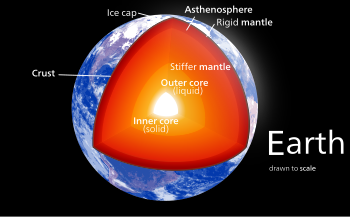Examples
Earth

|
Main article: Earth's mantle |
The Earth's mantle is a layer of silicate rock between the crust and the outer core. Its mass of 4.01 × 1024 kg is 67% the mass of the Earth.[1] It has a thickness of 2,900 kilometres (1,800 mi)[1] making up about 84% of Earth's volume. It is predominantly solid, but in geological time it behaves as a viscous fluid. Partial melting of the mantle at mid-ocean ridges produces oceanic crust, and partial melting of the mantle at subduction zones produces continental crust.[2]
Other planets
Mercury has a silicate mantle approximately 490 kilometers (300 miles) thick, constituting only 28% of its mass.[1] Venus's silicate mantle is approximately 2,800 kilometers (1,700 miles) thick, constituting around 70% of its mass.[1] Mars's silicate mantle is approximately 1,600 kilometers (990 miles) thick, constituting ~74–88% of its mass,[1] and may be represented by chassignite meteorites.[3]
Moons
Jupiter's moons Io, Europa, and Ganymede have silicate mantles; Io's ~1,100 kilometers (680 miles) silicate mantle is overlain by a volcanic crust, Ganymede's ~1,315 kilometers (817 miles) thick silicate mantle is overlain by ~835 kilometers (519 miles) of ice, and Europa's ~1,165 kilometers (724 miles) km silicate mantle is overlain by ~85 kilometers (53 miles) of ice and possibly liquid water.[1]
The silicate mantle of the Earth's moon is approximately 1300–1400 km thick, and is the source of mare basalts.[4] The lunar mantle might be exposed in the South Pole-Aitken basin or the Crisium basin.[4] The lunar mantle contains a seismic discontinuity at ~500 kilometers (310 miles) depth, most likely related to a change in composition.[4]
Titan and Triton each have a mantle made of ice or other solid volatile substances.[5][6]
Asteroids
|
See also: 4 Vesta § Geology |
Some of the largest asteroids have mantles;[7] for example, Vesta has a silicate mantle similar in composition to diogenite meteorites.[8]